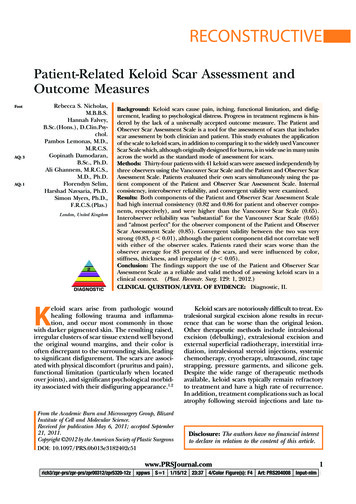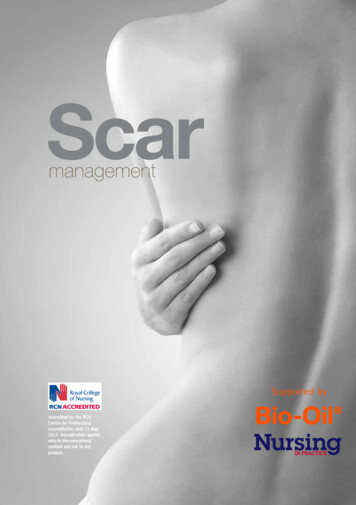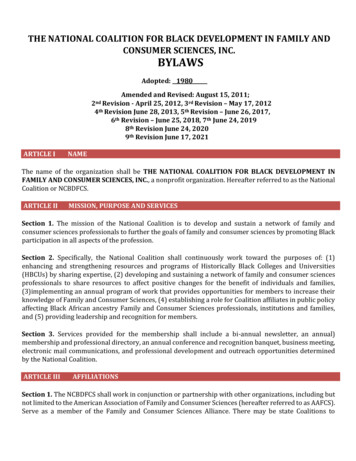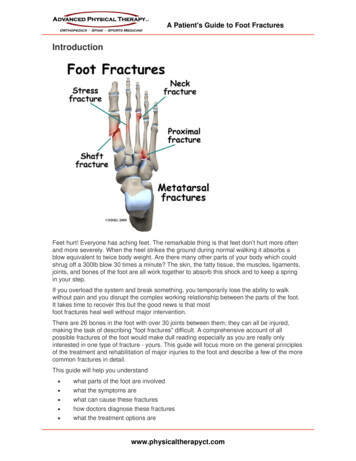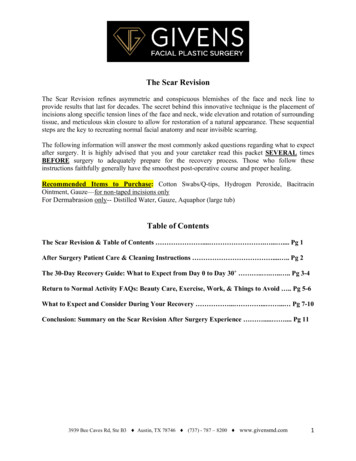
Transcription
The Scar RevisionThe Scar Revision refines asymmetric and conspicuous blemishes of the face and neck line toprovide results that last for decades. The secret behind this innovative technique is the placement ofincisions along specific tension lines of the face and neck, wide elevation and rotation of surroundingtissue, and meticulous skin closure to allow for restoration of a natural appearance. These sequentialsteps are the key to recreating normal facial anatomy and near invisible scarring.The following information will answer the most commonly asked questions regarding what to expectafter surgery. It is highly advised that you and your caretaker read this packet SEVERAL timesBEFORE surgery to adequately prepare for the recovery process. Those who follow theseinstructions faithfully generally have the smoothest post-operative course and proper healing.Recommended Items to Purchase: Cotton Swabs/Q-tips, Hydrogen Peroxide, BacitracinOintment, Gauze—for non-taped incisions onlyFor Dermabrasion only-- Distilled Water, Gauze, Aquaphor (large tub)Table of ContentsThe Scar Revision & Table of Contents . . . . Pg 1After Surgery Patient Care & Cleaning Instructions . . Pg 2The 30-Day Recovery Guide: What to Expect from Day 0 to Day 30 . . . . Pg 3-4Return to Normal Activity FAQs: Beauty Care, Exercise, Work, & Things to Avoid . Pg 5-6What to Expect and Consider During Your Recovery . . . Pg 7-10Conclusion: Summary on the Scar Revision After Surgery Experience . . Pg 113939 Bee Caves Rd, Ste B3 Austin, TX 78746 (737) - 787 – 8200 www.givensmd.com1
After Surgery Patient Care & Cleaning Instructions1. Leave all tape over incision lines in place until your next post-operative visit. If the tape comesoff prior to this appointment or there was no tape placed, clean incisions with hydrogen peroxideon a cotton swab. Then, apply a layer of Bacitracin ointment to the same sutures lines with a newcotton swab. This routine will need to be repeated 4 times per day for one week. It is NOTnecessary to perform these cleanings throughout the night. New cleaning and care instructionswill be provided at the one week post-operative visit.2. Care after Dermabrasion: Clean treated sites with distilled water on a gauze using a moderatelyfirm scrub to remove any remnant ointment, debris, and yellow scabbing. Gently pat your facedry. Then, apply a thick coat of Aquaphor ointment over all treated areas. This routine will needto be repeated at least 6 times per day (or every 2 hours while awake) for one week. It is NOTnecessary to perform these cleanings throughout the night. This cleaning process is a lot of workand somewhat painful but extremely important. You must work at it diligently in order to get agreat result and prevent infection. New cleaning and care instructions will be provided at the oneweek post-operative visit. Do NOT allow the face to scab and become dry. It is impossible to over lubricate. Aquaphorointment should be applied in a thick layer similar to frosting a cake. It is important toremove and lift off all yellow scabs to allow for proper healing. If a yellow crust remainsdespite adequate soaks, place a very thick layer of Aquaphor ointment directly over the scabfor 10 minutes. Then, massage the area to loosen the scab and lifting away the crust. Do NOT wear makeup or use your regular skin care products for 2 weeks after surgery or onany unhealed/raw areas.3. Daily showering is recommended with gentle hair washing and delicate cleansing of any nontaped incision lines. If the repaired surgical site involves your hairline or if dermabrasion wasperformed, use baby shampoo ONLY for 2 weeks. Do NOT use hydrogen peroxide or Bacitracinointment in your hair. Blow drying hair is allowed after 2 weeks but due to temporary numbnessof the scalp and healing incision lines use the COOL setting only.4. Swelling and bruising increase for 2-3 days following surgery. Asymmetric or uneven swellingand bruising (ie, swelling and bruising that is more pronounced on one complete side or specificarea of the face) is both common and temporary. Use of cool compresses and head elevation isstrongly recommended to help keep swelling to a minimum.5. Monitor for significant swelling around the surgical site that feels firm or fluid-filled. If there isconcern for a seroma or hematoma (ie, fluid or blood-filled collection under the skin), pleasecontact the office immediately at (737) 787 - 8200 to determine whether or not an in-office visitand possible fluid drainage is necessary.3939 Bee Caves Rd, Ste B3 Austin, TX 78746 (737) - 787 – 8200 www.givensmd.com2
The 30-Day Recovery Guide: What to Expect from Day 0 to Day 30 Dr. Givens strongly believes that patient education is key to a successful surgical recovery. Below isan easy to follow 30-day Scar Revision Recovery Guide so that you will know what to expectduring the healing period. It is important to understand that the provided timeline represents a generalrecovery time frame and cannot be guaranteed.Scar Revision Recovery: Week 1Day 0 (Surgery Day). Once surgery is complete, you will be taken to the recovery room where aspecialized nursing team will monitor and care for you prior to your departure from the operative facility.You will need a friend or family member (no ride-hailing services or self-driving) to drive you to a homeor hotel of your choice that is located within 30-minutes of the operative facility for the first night. Youwill need a caretaker to be available to you for at least the first 3 days after surgery. It is important to keepyour surgical dressing in place, rest on your back in a recliner or in bed with your head elevated, andmonitor for pain and nausea overnight. For those who have either elected or been required to remain inthe post-surgery facility overnight, the nursing staff will be your assumed caretaker during your stay. Ofnote, observation in the overnight facility is determined PRIOR to scheduling surgery.Day 1. You will come to the office the morning after surgery for a general cleaning and surgical check.Your caretaker must come with you to this appointment to both aid you physically and help youremember what is discussed during the visit. Your surgical dressing will be removed. If a drain wasplaced, it will be removed in the office as long as your repair site does not appear to have accumulatedfluid overnight. All of your suture/staple lines will be cleansed, and a thorough review of your at homecleaning routine will be provided. Fresh tape will be applied to all incision lines and will likely stay inplace until your next office visit. In the unlikely event that a fluid collection is observed during this visit,you will need to remain at a residence located within 30-minutes of the office/surgical facility until statedotherwise by Dr. Givens to allow for expedient care and monitoring. You may bathe after yourappointment. Daily showering is recommended with gentle hair washing and delicate cleansing of anynon-taped incision lines. If the repaired surgical site involves your hairline or dermabrasion wasperformed, use baby shampoo ONLY for 2 weeks. Do NOT use any other hair products. Do NOT usehydrogen peroxide or Bacitracin ointment in your hair.Days 2-4. Swelling and bruising will increase on days 2-3, but will usually peak around day 4 beforegradually resolving. Most patients describe moderate discomfort, stiffness, and tightness of the face/neckrather than sharp pain. Swelling and bruising also cause temporary numbness and tingling. Ifdermabrasion was performed, you will notice that the treated area resembles a deep sunburn that issensitive and raw. You may also notice fluid exuding from the skin, which is temporary normal serousdrainage. Your cleaning/lubrication regimen is a lot of work and somewhat painful but extremelyimportant. Your pain medication should be used sparingly and as prescribed by Dr. Givens. In addition,the use of cool compresses, head elevation, and Extra Strength Tylenol relieves this discomfort andtightness best.3939 Bee Caves Rd, Ste B3 Austin, TX 78746 (737) - 787 – 8200 www.givensmd.com3
Days 5-7. You will come to the office on Day 7 for suture/staple removal, which is quick anduncomplicated because it is done with small delicate instruments to minimize discomfort. If dermabrasionwas performed, you will come to the office on Day 5 for a wound check. You will be transitioned fromAquaphor ointment to a steroid cream between Days 5-7 at the discretion of Dr. Givens. Most patients“turn the corner” between days 5 and 6, and the majority of patients no longer need prescription painmedication. While you will feel much better after your sutures/staples are removed, you must understandthat this is NOT going to be your final result. Pause and read that again. At this point, a large amount ofthe post-operative swelling and bruising will have subsided. Temporary numbness/tingling, tightness,stiffness, redness, and discomfort may persist but to a lesser degree. This is NORMAL. You will see asignificant improvement in the shape of your face/neck over the next few weeks to months. You shouldalso start feeling more comfortable moving about.Scar Revision Recovery: Week 2Days 8-14. You will still have some swelling and bruising around the affected areas and may experienceresidual but temporary numbness, tingling, and tightness. This is normal after scar revision and should notcause concern. If dermabrasion was performed, you many now wash your face with a gentle, non-foamingfacial cleanser and start applying a zinc oxide/titanium oxide sun block without active chemicalingredients to both prevent irritation and hyperpigmentation of your newly resurfaced skin. You may stillhave some stinging and discomfort, and your skin will remain red-pink. This is NORMAL. At the end ofthe second week post-surgery, many patients feel “like themselves” again and are ready to return to work,school, or other obligations with a lifting restriction of no more than 15-lbs. Leisurely walking isencouraged. Do NOT perform household cleaning or any other activity that elevates your heart rate.Scar Revision Recovery: Weeks 3 & 4Days 15-30. You will begin to see real improvements in your facial/neck contour. However, it will take aMINIMUM of 6-8 weeks for ALL swelling and bruising to resolve and a FULL year for the face to reachits final contour. During your one month office visit, a small steroid injection into thickened regions ofthe face and neck may be performed at the discretion of Dr. Givens. The steroid injection helps to softenhealing tissues. You can now return to all regular activities and exercise without people noticing outwardsigns of your procedure. Incision sites will have a pinkish-red hue but this should fade with time.Scar Revision Recovery: Day 30 & BeyondDay 30 . After the one month post-operative visit, you should be back to doing ALL normal activitiesand enjoying life with your new look. While it can take up to a year for very minor swelling, bruising,tightness, and numbness to resolve, this is typically only noticeable to you. Remaining follow-up visitswith Dr. Givens (ie, 3-month, 6-month, 1-year) are to assess your progress. Photographic documentationwill be performed at each visit as well. You will see great changes as the swelling continues to go down.3939 Bee Caves Rd, Ste B3 Austin, TX 78746 (737) - 787 – 8200 www.givensmd.com4
Return to Normal Activity FAQs: Bathing, Beauty Care, Exercise, Work, &Things to AvoidBathing You may take a shower and wash your hair starting 24-hours after surgery (ie, Day 1 afterremoval of the surgical dressing). Daily showering is recommended with gentle hair washing and cleansing of any non-tapedincisions. Wetting of your suture and staple lines will occur, but do NOT submerge your healing incisionsites. If the repaired surgical site involves your hairline, use baby shampoo ONLY for 2 weeks. Youmay brush your hair with a large-toothed comb. Do NOT use hydrogen peroxide or Bacitracinointment in your hair. Blow drying hair is allowed after 2 weeks but due to temporary numbnessof the scalp and healing incision lines use the COOL setting only. You may cleanse your face gently with a mild soap after 1 week. If dermabrasion was performed,you many wash your face with a gentle, non-foaming facial cleanser after 1 week.Makeup, Hair Care, & Salon Maintenance Makeup may be applied starting 2 weeks after surgery. If a dermabrasion was performed, doNOT use any of your regular skin care products or apply makeup for 2 weeks. Do NOT applymakeup to any unhealed/raw areas. Retinol-containing products may not be used until 1 monthafter surgery. If the repaired surgical site involves your hairline, you may have your hair washed at the salon 3weeks after surgery, but a hand blow-dryer only must be used on the low setting. Avoid haircoloring and use of a wig and/or artificial hair extensions until 3 weeks after surgery. Timing of all other beauty maintenance procedures including eyebrow and eyelash treatments,waxing/sugaring, and facial tattooing depends on the location of reconstruction and should bediscussed with Dr. Givens prior to scheduling.Clothing Choices, Glasses, Contacts, & Nasal Dressings Wear clothing that fastens in the front rather than clothes that pull over your head to avoidpulling on suture/staple lines and dermabraded areas for 2 weeks after surgery. You may wear glasses and contacts. For eyelid procedures, do NOT wear contacts for 2 weeks.Exercise & Other Extracurricular Activities During the first week after surgery, you are encouraged to leisurely walk. Do NOT performstrenuous activities such as cardio/aerobics, jogging, swimming, tennis, golf, Pilates, yoga, barre,spin, high intensity interval training, and weight-lifting for 3 FULL weeks. You should avoid any activity that increases your heart rate, even bedroom activities (ie, sexualactivity of any type) for 3 FULL weeks. You may be “up and around the house” but do NOT perform house cleaning, bending, or liftingmore than 15-lbs for 3 weeks.3939 Bee Caves Rd, Ste B3 Austin, TX 78746 (737) - 787 – 8200 www.givensmd.com5
Return to Work Most patients take about 1-2 weeks off from work, school, or other obligations depending on theprocedure performed. Depending on your individual recovery process and job requirements, youmay be able to return sooner or need to wait a bit longer. If your job involves heavy lifting (ie, more than 15-lbs) or a significant amount of public contact,you will need to plan on taking a full 3 weeks off.Things to Avoid Avoid excessive facial expressions and emotional states (ie, crying, laughing, yawning), bending,lifting, and straining for 2 weeks after surgery. Avoid direct application of ice to the face or neck as extremes of temperature can damage thehealing tissues and result in an unsatisfactory outcome. Do NOT sleep with any cool compresseson your face or neck. Avoid use of hot tubs or extremes of heat for 3 weeks after surgery as this can dilate your bloodvessels and cause hematoma formation. Avoid using any and all medications listed on the “Medications to AVOID Before Surgery” pageof the website, which can be found under the Patient Resources tab of the toolbar then theSurgery & Post-Treatment Care drop-down menu. Avoid quickly rising from a sitting position. Instead, slowly stand and give yourself a fewseconds before walking forward to ensure you do not become light-headed, dizzy, orunexpectedly syncopal. Avoid caffeine, tea, and other dehydrating substances. Drink plenty of fluids and electrolytes tostay hydrated. Avoid direct sun exposure to any surgical sites for 9 months after surgery. Use sun protectionincluding sun block, wide brimmed hats, and sunglasses. Avoid driving or operating heavy machinery while taking narcotic pain medication. Do NOT smoke, vape, or use any nicotine-related products (ie, nicotine patches, nicotine gum,chew/dip) as these substances cause significant and detrimental blood vessel constriction. Vesselconstriction decreases required blood flow to the healing tissues of the face/neck and mayultimately result in delayed wound healing, unsatisfactory cosmetic outcome, and even skinnecrosis.3939 Bee Caves Rd, Ste B3 Austin, TX 78746 (737) - 787 – 8200 www.givensmd.com6
What to Expect & Consider During Your RecoveryAs with any major surgery, scar revision carries the risk of bleeding, infection, pain, skin changes orloss, continued or new functional deficit, continued or new asymmetry of the facial/neck anatomy,fluid collection (ie, hematoma/seroma), temporary or permanent facial nerve injury, paresthesia (ie,numbness), herpetic outbreak, hyperpigmentation, development of milia and/or facial acne, hairthinning or loss, vision changes or loss, corneal abrasion, blood clot formation, cosmeticabnormality, unsatisfactory scarring, and/or the need for additional surgery. The followinginformation outlines what to expect and be aware of during the recovery process after facialreconstruction.Bruising & SwellingAfter the surgical dressing is removed, your face and/or neck may appear swollen and lumpy withvariable amounts of bruising or discoloration. Bruising and swelling increase for 2-3 days followingsurgery and are often asymmetric/uneven (ie, swelling and bruising that is more pronounced on onecomplete side or specific area of the face). Use of cool compresses, head elevation, leisurely walking,Arnica montana, and avoidance of any and all medications listed on the “Medications to AVOIDBefore Surgery” page of the website will help to decrease bruising, swelling, and inflammation.While the majority subsides within 2 weeks, it will take a MINIMUM of 6-8 weeks for ALL swellingand bruising to resolve and a FULL year for the face and/or neck to reach their final contour. Cool Compresses: Wash cloths dipped in ice water or cool gel packs can be applied to theface/neck for 15-minutes a few times daily during the first week after surgery to help reduceswelling and discoloration. Do NOT apply direct ice as extremes of temperature can damage thehealing tissues and result in an unsatisfactory outcome. Do NOT sleep with cool compresses onyour face and neck. Head Elevation: Rest on your back with your head elevated above the level of your heart/chestby sleeping in a recliner or on 2-3 pillows in bed. You will notice that you tend to be moreswollen upon waking in the morning and less by the evening. Do NOT sleep on your side orstomach for 3 weeks after surgery. Arnica montana: This over-the-counter sublingual homeopathic preparation when taken infrequent doses, for a few days before and continuing for a week after surgery, seems to have theability to diminish post-operative bruising.Numbness & Hair ThinningParts of the face and/or neck will be numb after surgery. This is both a normal and expected part ofthe recovery process after scar revision. As sensation returns over the next few months, you mayexperience itching, tingling, stinging, or intermittent sharp pain. There may be transient thinning ofthe hair in areas adjacent to the suture lines within the hairline or diffusely on the scalp. This isknown as “hair shock”, in which a stressor (ie, surgery) triggers hair loss temporarily. Unfortunately,it is completely unpredictable which patients will incur hair loss. Although the new hair shaft cantake 3-6 months to visibly regenerate, rest assured your hair will return.3939 Bee Caves Rd, Ste B3 Austin, TX 78746 (737) - 787 – 8200 www.givensmd.com7
Pain & DiscomfortModerate discomfort, stiffness, and tightness are expected, temporary, and very normal experiencesduring the healing and recovery process after scar revision. While it may take 2-3 weeks forresolution, significant improvement is noticed after 1 week. Prior to surgery you will be providedwith a series of prescribed medications that are important to take as instructed as each one serves aspecific purpose in the recovery process. Pain Medication: There is usually only minimal-moderate actual pain following scar revision,which resolves within the first couple of days after surgery. However, you may experience theabove described and expected discomfort and tightness, which can take longer to completelyresolve. These sensations will often seem worse at night, especially when one becomes quiteanxious. Excessive intake of pain medication, particularly in the immediate post-operativeperiod, often results in light-headedness, nausea, and constipation—making recovery moretedious. Thus, a regimen of cool compresses and Tylenol Extra Strength is often more effective.However, if the pain is severe, you may use your provided narcotic pain medication as prescribedby Dr. Givens. Remember to take pain medication after eating to avoid nausea. Do NOT takenarcotic medication at the same time as Tylenol ingestion. If you develop narcotic-inducedconstipation, you may take an over-the-counter laxative or stool softener from your localpharmacy. Do NOT drive while taking prescription pain medication. Do NOT take aspirin oribuprofen. Anti-Depressant Medication: It is not unusual for patients to go through a period of milddepression after cosmetic surgery no matter how much they wanted the operation and wereeducated on what to expect post-operatively. Remember, same day surgery does not mean sameday results. If you are able to realize that this is a very temporary phase, the emotional aspect willresolve. If you take anti-depressant medications, please continue per your normal pre-surgicalroutine unless specifically instructed otherwise. If you experience any suicidal or homicidalideations, please contact both your psychiatrist and Dr. Givens. While Dr. Givens does NOTprescribe anti-depressant medications, she would like to ensure that you have all of the care andtreatment that you need after surgery.InfectionPrior to surgery you will be provided with a prescription for an antibiotic medication. It is importantto fill this prescription BEFORE your surgery, take as instructed, and make sure to finish the entirecourse as this medication serves a specific purpose in the recovery process. The first dose is to beadministered the day BEFORE your surgery. If you develop an allergic reaction or signs/symptomsof an infection including persistent redness and/or drainage from incision sites, call the officeimmediately as a new/different medication or treatment may be required.Fluid Collection & HematomaIf you develop a pronounced collection of fluid of the face and/or neck, you should call the officeimmediately. You will likely be instructed to come to the office for evaluation and possibleaspiration of the fluid (ie, sticking a needle into the area of fluid accumulation to suck out the fluid)followed by pressure dressing application. You will be instructed to keep the pressure dressing onand in place until you are re-evaluated in the office the following day. If more fluid has accumulated,re-aspiration of fluid with new pressure dressing application will be performed on a daily basis until3939 Bee Caves Rd, Ste B3 Austin, TX 78746 (737) - 787 – 8200 www.givensmd.com8
all fluid has resolved. In the event a rapidly expanding fluid collection (ie, hematoma) develops, youmay be required to go back to the operating room for drainage, cauterization (ie, heated ligation of ablood vessel causing the bleeding), and possible drain placement. The formation of a rapidlyexpanding hematoma, while rare, is taken very seriously and must be treated emergently to preventskin necrosis.Scars & Revision SurgeryAny time a cut is made on the body there will be a scar. However, scar visibility depends on severalfactors. Scar revision requires deliberate placement of incisions along specific tension lines of theface to minimize scar visibility. Healing incision lines will have a deep pink hue with variableamounts of swelling and thickening initially. Post-surgical scars will continue to soften and fade forup to a year. Most of the time, an experienced surgeon can produce long-lasting results that both ofyou are pleased with—often for several decades. However, you must remember that even in the mostexperienced hands, there are no guarantees in surgery. Further surgical intervention is NOTscheduled prior to the 6-month post-operative mark and more likely closer to a year unless absolutelynecessary. It is imperative to allow for most ifnot all of the post-operative swelling and inflammation to resolve prior to further operation. Finally,you must understand that while surgery can improve the youthful appearance, it cannot stop theaging process of the body over time. Steroid Injection: A low-dose steroid may be injected into uneven or thickened areas ofscarring of the face and neck. It is common to require at least a single injection at the onemonth post-operative office visit. Timing of the injection, amount injected, and need forcontinued injections will be determined by Dr. Givens. The steroid is not systemic; rather, itis localized only to the part of the face and/or neck it is injected into. Massage: Regular massage of uneven or thickened areas of the face and neck is encouragedstarting at 3 weeks, but not before this time period unless stated otherwise by Dr. Givens.Massage can be performed 3-4 times per day for 1-3 minutes each time.Dermabrasion Specific Cold Sores: Prior to surgery you will be provided with a prescription for anti-viral medication. Itis important to fill this prescription BEFORE your surgery, take as instructed, and make sure tofinish the entire course as this medication serves a specific purpose in the recovery process. Thefirst dose is to be administered BEFORE your surgery. The herpes virus is very common and anoutbreak can lead to unwanted facial scarring. Whether or not you have a history of herpeticoutbreaks is irrelevant as EVERY patient will be instructed to take the prescribed antiviralmedication. If you develop cold sores or an allergic reaction, call the office immediately as anew/different medication or treatment may be required. Milia & Acne: Milia, or small white bumps, occur where the new layer of healing skin hasovergrown the underlying glands. They may appear within the first 1-2 months after treatmentand can be gently scrubbed for removal. However, persistent milia may require the assistance ofDr. Givens. Post-operative facial acne may occur as well. Please call the office if you are havingan acne outbreak as medication may be required for treatment. Skin Color & Texture: Your skin will have a tomato or cherry red coloring similar to a deepsunburn for a few weeks after surgery. This will gradually transition to a pink hue that will fade3939 Bee Caves Rd, Ste B3 Austin, TX 78746 (737) - 787 – 8200 www.givensmd.com9
over the next few months. This is NORMAL. You will see a significant improvement in the tone,texture, and color of your skin over the next 3-6 months.Hyperpigmentation: Some skin types are prone to hyperpigmentation, or dark spots, after laserresurfacing. Hyperpigmentation is triggered by sun exposure. Thus, avoidance of direct sunexposure and the use of sun protection (ie, sun block, wide brimmed hats, sunglasses) isnecessary especially in the initial healing period. If you notice development ofhyperpigmentation, call the office immediately as there are prescription-based topical creamsavailable for treatment.3939 Bee Caves Rd, Ste B3 Austin, TX 78746 (737) - 787 – 8200 www.givensmd.com10
Conclusion: Summary on the Scar Revision After Surgery Experience1. After the surgical dressing is removed, your face and neck may appear swollen and lumpy withvariable amounts of bruising or discoloration. Bruising and swelling increase for 2-3 daysfollowing surgery and are often asymmetric/uneven. Remember, this is temporary and willsubside to a large extent within 2 weeks. However, it will take a MINIMUM of 6-8 weeks forALL swelling and bruising to resolve and a FULL year for the face and neck to reach their finalcontour.2. Dermabrasion: The cleaning process during the first week after surgery is a lot of work andsomewhat painful but extremely important. You must work at it diligently in order to get a greatresult and prevent infection. Your skin will have a tomato or cherry red coloring similar to a deepsunburn for a few weeks after surgery and will gradually transition to a pink hue that will fadeover 3-6 months. However, it will take a FULL year for the face to reach its final contour.3. Call the office if you experience a persistent temperature of 101 F or higher, sudden significantswelling or discoloration, unusual bleeding, non-serous discharge from the wound or otherevidence of infection, or development of any drug reaction, hyperpigmentation, facial acne, orcold sores. There is a 24-hour answering service available during non-office hours for urgentpost-operative concerns4. Each patient will have a unique experience, and you should always follow the directions providedby Dr. Givens. Those who educate themselves before surgery and follow Dr. Givens’ postoperative care instructions usually have the easiest recoveries and the best outcomes.5. Most of all—BE PATIENT during the healing process. Remember, same day surgery does NOTmean same day recovery. Healing is a gradual process. It is normal to be impatient and feeldiscouraged while waiting for swelling, bruising, and discomfort to diminish. Allow yourselfextra rest, a nutritious diet to promote healing, and avoid stress during your recovery.3939 Bee Caves Rd, Ste B3 Austin, TX 78746 (737) - 787 – 8200 www.givensmd.com11
The Scar Revision . The Scar Revisionrefines asymmetric and conspicuous blemishes to of the face and neck line . wide elevation and rotation of surrounding tissue, and meticulous skin closure to allow for restoration of a natural appearance. These sequential steps are the key to recreating normal facial anatomy and near invisible scarring.


